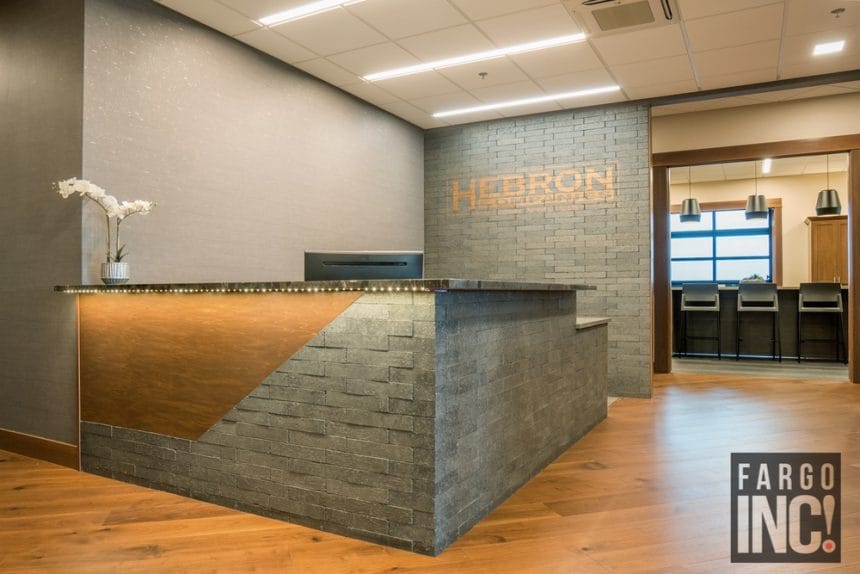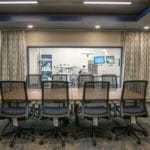Photo by Hillary Ehlen
Expert
Kim Manuel (ASID, LEED AP)
Principal, Director of Interiors & Marketing at BlueStone Interiors
1. Make the right first impression
What is the first impression you want your guests to feel when they enter your office? What will inspire your employees and communicate to your customers what sets your business apart? Is a formal lobby with a receptionist and black leather lounge chairs appropriate or does a casual coffee bar with a long high top island with bar-style seating feel more appealing to your guests? Featuring your business culture by using subtle corporate colors in the flooring, fabrics or a light fixture is a great way to indirectly show your brand.
2. Make sure guests can navigate your space easily
Space planning, traffic flow and wayfinding work together. Simple design features such as flooring direction or brighter lights indicating “come this way” are easy to incorporate. There are many indirect ways to direct traffic in an interior space. “Past the red flooring” or “after the skylight” are examples of traffic flow that you don’t need a sign with copy for. They are intuitive. You will need some signage for legal purposes as well as branding identity. Incorporate materials in your signage that reflect your business and mission. That could be monochromatic silhouette graphics of an athlete or a rustic barn wood backdrop with die-cut backlit steel.
3. Look up and around, not just the floor plan
A reflected ceiling plan with lighting specifications makes up over 50 percent of the surface square footage of your interior office space investment. Don’t skip designing this square footage in conjunction with your floor plan. LEDs are efficient with energy consumption, although come with a lot of complicated options. Color Temperature? CRI? Wattage? Consider the color of the lamp that fits your needs best.
Spaces are very uncomfortable that have a hodgepodge of various lamp colors in the same room. Specify a color temperature that fits your type of function and make sure all fixtures are consistent in that room. Warmer colors are best for private, quiet areas like fine dining or mother’s rooms. Neutral colors are best for general work areas. The cool blue colors have been found to be overstimulating and should rarely be used in office design.
Save energy in common areas by reducing the lumen output in hallways and increase lumens task areas. Restrooms and dressing rooms should have a high CRI (Color Rendering Index) to complement your best skin tones.
4. Where should meeting spaces be? Who should have the most natural light?
Where does collaboration happen in the office? Break rooms have become a favorite impromptu meeting hub of many offices. Many businesses provide healthy snacks and beverages throughout the workday. This may be why foot traffic studies show the breakroom has the most traffic over any other space in the office. You are bound to run into teammates here.
Providing a standing height long island for a quick conversation or spreading out a project to collaborate on has become a highly productive use of square footage. Floor to ceiling markerboard walls is another great way to sketch concepts and details easily in any meeting space, including the break room. Incorporating USB outlets near lounge end tables and at counter level for easy alternate work areas.
Small two to four-person conference rooms with lounge chairs and a coffee table have replaced traditional small conference rooms with task chairs and standard 30” high tables. Teams are more open with one another and comfortable for discussions when not hiding behind a table. Studies show that the best brainstorming sessions are performed in intentional collaboration spaces with markerboards, and technology to facilitate. The best space planning layouts tend to have a blend of ‘me’ and ‘we’ spaces to effectively perform a variety of tasks throughout your workday.
5. Future Growth and Recession
Consider potential expansion areas to maintain the workflow of more offices, conference spaces, production areas, etc. Also, consider areas to easily sublease square footage in the future should you reduce in size. Where would the existing hallways connect into future space? What structural or plumbing barriers are adjacent to your office suite? How does your site layout allow for potential building additions? How will building code requirements change when adding square footage?
Q&A
Redesigning an office can be a time consuming and expensive project. What tips do you have for simplifying the process and making it go as smooth as possible?
This is not something you do every day so, as an owner, it is difficult to know the process quickly. How long is the design process? What do I need to submit for a building permit? How much time do design, permitting and construction take? These are all questions an expert can answer. Hiring a design professional to collaborate with to set up a realistic schedule and budget will eliminate costly surprises along the way.
A professional interior designer will probe at out of the box questions for you to consider. One probing question example may be about lighting color temperatures. You may desire to have a sterile blue-hued room in a security office vs. a warm candlelit color temperature of light in the mother’s nursing lounge. What light fixture specifications should I bid and how many, how high and far apart? These are small discussions that are easy lighting specifications to design before you ‘blindly’ relamp your entire building with glaring ‘blue light special’ LEDs you don’t even want to last their 30-year lifespan!
Where should you start when redesigning an office? Who should you receive input from when deciding on the redesign?
Programming is the first step to a successful office redesign. During this process, all key stakeholders or department representatives should be involved. This creates buy-in with staff and ultimately delivers the most successful space planning outcome increasing productivity. Who needs close proximity to each other to be efficient with their tasks? Who talks too much and should not be close to one another? Let’s be honest, there is one in every office.
The executive team cutting the check for the remodeling fees may not know exactly how their entire team operates day to day. We are all creatures of habit and think we know how each person in the office works, although it is best to research ways to improve efficiencies during this opportunity in the design process. Having an outside designer interview and observe all office operations/functions, oftentimes results in fresh new ways to consider for efficiently operating. Designing options on paper is much cheaper than construction. These space planning flow and return on investment of efficiency conversations typically hit home with the financial stakeholders of all businesses.
What equipment and sizes are currently used? What changes do you see in the future- paperless or off-site storage? Who has guests in their offices or work areas? How many people are typically in those meetings? Should each staff team member have standing to sitting adjustable height desks for ergonomic flexibility or could this be accomplished with a variety of break out areas throughout the office? What other functions can the board room that is used two times a year be multi-purposed for?
There’s a lot of different psychology when it comes to colors of office space. What colors are good for different types of offices?
Color and texture go hand in hand. The same color blue on a dull, rustic chipped wood sign versus vibrant blue highly polished metal, give different feelings. In your office space, always use a combination of a neutral backdrop in whites, grays or brown tones along with a complementary primary color group (blue, green, red or yellow tones) to create the best interior palettes.
Blues are calming and stimulates productivity. Green reflects nature bringing feelings of growth and a calming balance. Red is energizing creating competitive feelings. Yellow feels cheerful and inspires creativity. When selecting your color palette, also consider the texture of the materials. “Resimercial” is a trend where the durability and function of commercial office elements are reflecting the soft, comforting features of our homes. Textures in a live wall with green plants, upholstered furnishings with textural soft wool pillows and the illusion of mosaic rugs in carpet and ceramic tile pattern layouts are examples of these. What is the color ‘feeling’ you want your guests and staff to be influenced with?








